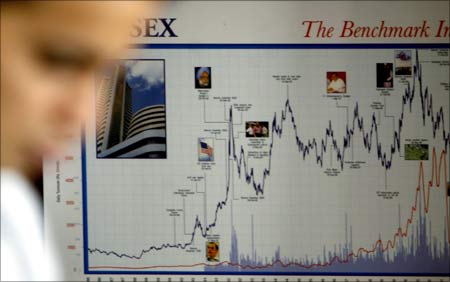
Last week, the Securities and Exchange Board of India pulled up promoters of four companies -- Welspun Corp, Ackruti City, Murli Industries and Brushman India -- for allegedly rigging their own stocks.
The promoters of these companies allegedly colluded with stock market operators, Sanjay Dangi and his associates and the Ashika Group, to manipulate their stock prices.
Following Sebi's orders, stock prices of these companies fell sharply.Ackruti City, Welspun Corp and Murli Industries fell by 20, 27 and 20 per cent, respectively, the next day.
While many operator-driven stocks allow traders to make a quick buck, for retail investors who have invested in these stocks, things could be difficult.
. . .

It is not easy to identify a stock that is being manipulated vis-a-vis another which is rising due to sentiment.
Yet, an investor can look at signs that may point towards manipulation and stay away.
Sharp price movements
All operator-driven stocks see a meteoric rise and fall. Unfortunately, even the best companies have fallen prey to operators.
In the early nineties, Harshad Mehta drove ACC's price to Rs 10,000 a share. Today, the stock closed at Rs 976.
Typically, these stocks hit the upper circuit often while these are on a rise. Similarly, they go on a free fall when things are bad.
Investors fall prey to these often. Ketan Dhiman invested in the initial public offering of Pochiraju Industries at Rs 20 a stock.
He saw the stock swing between Rs 60 and Rs 5 within a few months.
. . .

"In the first year, I offloaded the investment fearing there is an operator behind the share price movement," says Dhiman. Suryakant Lakhotia did the same with Valuemart Info Technologies, when he saw the price fluctuate from Rs 9 to Rs 30.
According to Deepak Mohoni, director, trendwatchindia.com, "At a first glance, the rise may be linked to operators, but there are a number of investors who pick up chunk shares for the long term. So, one can only be sure about the stock being operator-driven only after the event occurs."
However, experts say it is better to stay away from stocks that show such vast movements, unless the company has revenues of over Rs 1,000 crore or Rs 10 billion (largecap).
. . .

Performance does not justify
Another sign to look out for is the price versus performance mismatch in a stock. A spike in price without any justification is a strong indicator that an operator is manipulating the stock.
You will see that the price does not justify simple fundamentals such as revenues, profits, and price-to-earnings multiple of the stock.
"When you compare the stock to its peers, the P/E multiple needs to be discounted as the size of the company reduces," says SP Tulsian, an investment advisor.
For example, if the P/E multiple of a textile largecap company is 11 times, the P/E of a midcap one will be seven-eight times, while smallcaps and microcaps will be five times or lower.
. . .

He also points out a possibility that the owners could be manipulating the financials by forging a big order. However, these are not sustainable beyond a quarter or two in most cases.
"If you can't dissect the company's financials and be confident about it, it's better to stay away," Tulsian says.
Size matters
"As far as operators are concerned, smaller the company, the bigger the scope for manipulation. If an operator wants to play around with even one-two per cent of the company's stock, he/she needs to target companies that have a smaller market capitalisation, says Rs 100 crore (Rs 1 billion) or lower.
The need for finances makes it difficult for operator to try the same with a largecap stock, unless the promoters are part of the deal.
Retail investors could stay safe if they invest in bigger, established companies, rather than smallcap and microcap stocks.
. . .

Repeat offenders
There is a need to look at the stock history. Operators are known to rig the same stock at every opportunity they get.
Let's take Ackruti City.
The company was excluded from futures and options segment in 2009. The stock price of the company rose to Rs 2,364 in March, after hitting an all-time low of Rs 550 two months earlier.
"If you look at the stock's history, you would know that some stocks are repeat offenders, who have been pulled on earlier occasions, too" says Mohoni.
Most manipulations take place during the bull run to make the best of the buying frenzy. This also helps manipulators attract investors, despite lack of information. When stock prices are on a high, be extra cautious.